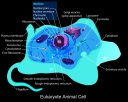|
On
the evolutionary origin of the eukaryotic cell |
Also see: |
| The first time that what went around came around "a quid pro quo with bacteria"
Mitochondria are the cell's "powerhouses," the sites where aerobic respiration breaks down food in the presence of oxygen into water and carbon dioxide, generating energy. Plants and many protists also contain plastids, where photosynthesis takes place, allowing these organisms to manufacture their own food from carbon dioxide and water. Chloroplasts and mitochondria are curious organelles indeed; they contain their own DNA and replicate independently. In fact, these organelles are descendants of symbiotic bacteria living inside the eukaryote host. They have become so dependent on their host that they can no longer live outside. Eukaryotes - including humans - are, in a very real sense, not individual organisms but colonies, and living proof that evolution frequently does not proceed according to the violent stereotypes of continuous struggle, of "nature red in tooth and claw." Sometimes the winning strategy is cooperation. | ||||||
|
Fossil
Museum Navigation:
Home Geological Time Paleobiology Geological History Tree of Life Fossil Sites Fossils Evolution Fossil Record Museum Fossils |


